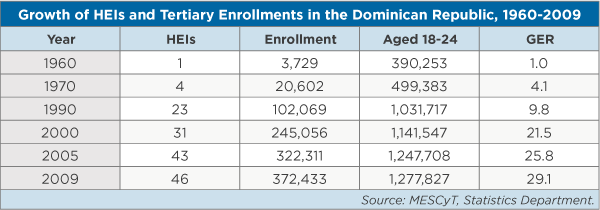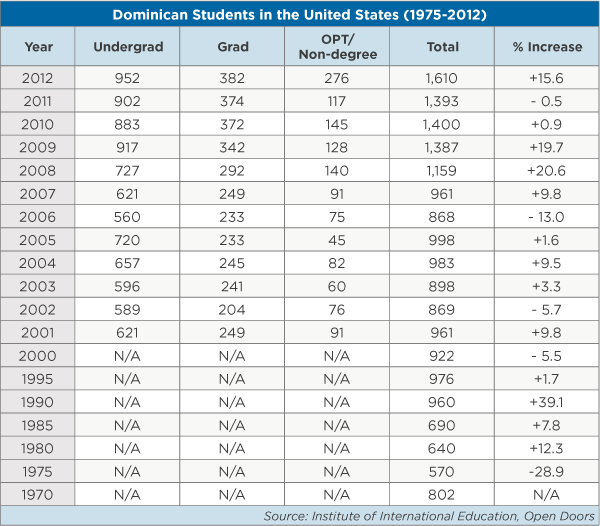Higher Education in the Dominican Republic: International Mobility and the Challenges of Expanding Domestic Provision
Nick Clark, Editor, World Education News & Reviews
Situated in the Caribbean on the eastern side of the island of Hispaniola, which it shares with Haiti, the Dominican Republic has a rapidly growing economy that has shifted in recent years from basic commodity exports (sugar, coffee, tobacco) to services such as tourism and telecommunications. With a population of just over 10 million people (2010) and the largest economy of the Central American and Caribbean region, the Dominican Republic is considered a middle-income country.
In tandem with the shift of the Dominican economy towards service industries, higher education enrollments have increased significantly over the last 20 years, from a gross enrollment ratio of 10 percent in 1990 to just under 30 percent in 2009. Nonetheless, future economic growth is being hampered by inadequate training opportunities for the labor force, according to a study released by the OECD in 2012, which describes “major deficiencies in the education sector at all levels.”
According to a World Bank report from 2006, “under-performance in education is the result of low levels of spending in the education sector, poor quality of teachers and low levels of teacher education, bottlenecks in the supply of secondary schools, and large management inefficiencies.”
Specifically, the OECD and World Bank point to major inequalities in the provision of primary and secondary education, which in turn have led to high repetition rates at the secondary level and high drop-out rates in the tertiary sector among underprepared students. In addition to recommending increased investment in schools and teacher training, the authors of the OECD report pinpoint a need to increase the provision of short-cycle tertiary programs to train students for the needs of the labor market and to provide multiple pathways to higher learning.
Current quality concerns may be one of the push factors compelling Dominican students to look overseas for study options. Between 2008 and 2010, the number of Dominican students travelling internationally for higher education increased 43 percent, from 2,317 to 3,306, according to data from the Unesco Institute of Statistics. The United States and Spain are the largest recipients of Dominican students, with Spain seeing a 210 percent increase in the number of Dominican students it hosted between 2008 and 2010, boosted significantly by a government-funded international scholarship program for graduate students.
Tertiary Enrollment Trends
Higher education is free in the public sector, most notably at the Autonomous University of Santo Domingo (UASD, Universidad Autónoma de Santo Domingo), which boasts 17 Regional University Centers around the country and enrolls 44 percent of the total tertiary student population.
In 2009, there were a total of 47 institutions of higher education in the Dominican Republic, enrolling some 373,000 students, up from 31 and 245,000 respectively in 2000.

Enrollment in tertiary studies is predominantly at the undergraduate level. In 2009, 94 percent of the 372,433 students in the tertiary system were studying at the undergraduate level, with just 2.5 and 1.7 percent in graduate and higher technical education respectively. Women accounted for 64 percent of the total tertiary enrollment between 2006 and 2009. Undergraduate studies predominantly train graduates for what the OECD describes as “low-skill, administrative and clerical functions.”
According to the OECD report cited above, deficiencies in the Dominican system begin with “poor quality and low effectiveness of schooling,” with high dropout rates at the secondary level. Nonetheless, the participation rate of 29.1 percent among college-age citizens (18-24 years old) represents significant enrollment growth over the last 30 years and places it on par with the global average. Unfortunately, the relatively high tertiary enrollment rate is tempered significantly by an average dropout rate of approximately 50 percent.
The UASD runs an “equalization program” for between 6,000-7,000 of the annual 30,000-35,000 intake in order to bring them up to speed and to address the inadequacies of their prior education. Nonetheless, fewer than 20 percent of students complete their degrees in five years or less, with most never completing.
As the OECD describes it: “the Dominican Republic’s education system is simultaneously an over-achiever in school enrollments and an under-performer in school attainment.”
A current priority for the Dominican government with regards to secondary and postsecondary reform is to improve and build capacity for effective and credentialed vocational education and training. In addition, the government has set a target of increasing participation in higher education to 50 percent of the college age population by 2018, involving an enrollment of 660,000 students, and representing a doubling of the 2005 enrollment total. If met, this would expand the tertiary system by almost 40,000 students per year when rapid demographic growth among the youth population is factored in. Furthermore, if attrition rates were reduced by 20 percent over the decade, at the current rate of participation, graduate output would increase from 34,412 in 2009 to 86,097, according to the OECD.
These figures bring up the question of capacity, both in terms of physical infrastructure and also in terms of qualified instructors. When considered as international academic mobility push factors, the questions of capacity and quality might be considered contributing factors to the recent increase in the numbers of Dominican tertiary students heading overseas.
International Academic Mobility
Under the government’s current 10-year plan for higher education, 10,000 international scholarships – across all levels – will be awarded for study at prestigious universities in key areas for national development and competitiveness. The Ministry of Higher Education, Science and Technology (MESCyT) has taken the lead role in administering the national scholarship program, the reform of teacher education and the internationalization of the system.
Currently, PhD production in the Dominican Republic is very low; however, the government has been expanding the provision of overseas fellowships for graduate education for one- to two-year masters and three- to four-year doctoral programs, in addition to English-language immersion initiatives. The lack of doctoral degrees in the Dominican Republic is directly related to the fact that there are no institutions offering doctoral degrees. To get a doctoral degree it is necessary to go abroad, either through private funding or through a fellowship.
The government has set a target of increasing the number of qualified PhDs by 300 each year to a level of 3,000 by 2018. It has promised a significant increase in the program of international fellowships in order to meet these goals, both in terms of sending Dominicans abroad to study and also in bringing foreign PhDs to the Dominican Republic to supervise doctoral programs.
In 2009, the Ministry provided 773 fellowships for graduate education abroad in partnership with international organizations. This was significantly less than the 1,390 awarded in 2008, but considerably more than previous years. Of the 773 fellowship recipients, 540 went to Spanish universities and 102 to the United States (among whom, 54 went to Nova Southwestern University in Florida.)

Academic travel to the United States among Dominican students has picked up significantly in recent years, almost doubling since 2005 to a total of 1,610 students in 2012. Graduate students account for over a quarter of all Dominican degree students in the United States, and while this may not be of particular note in and of itself, comparative to the 2.5 percent of students engaged in graduate studies domestically, it is significant. Also of note is that since the introduction of overseas fellowships in 2008, the number of students at the graduate level has increased some 35 percent to 382.

The IIE data described above count just Dominicans in the United States on student visas. It should also be noted that there are more than one million Dominicans, or those of Dominican descent, living in the United States today.
Among second-generation Dominicans in the United States, rates of educational attainment are high compared to other U.S.-born Latinos, with close to 60 percent of all Dominicans born in the United States, 25 years or older, having received some college education, with a 22 percent completion rate (Hernandez & Rivera-Batix, 2003).
Recently, some Dominican universities have partnered with foreign universities to provide joint doctoral degrees. Most notably, these partnerships have been with institutions in Spain (Universidad de Alcalá, Universidad del País Vasco, Universidad Politécnica de Valencia, Escuela de Organizacíon Industrial, Universidad Pompeu Fabra, Universidad Complutense de Madrid). Some of the agreements are institution to institution, while others are through MESCyT.
With regards to transnational provision, the OECD posits that there are opportunities for the Dominican Republic to consider the involvement of transnational providers of higher education, with particular benefits to be gained from the provision of specialized pathway programs as a means of bringing underprepared secondary graduates to a level suitable for tertiary study.
With regards to incoming academic mobility, the number of international students in the Dominican Republic represents less than 2 percent of the total enrollment in higher education, according to government figures.
Conclusion
Access to higher education in the Dominican Republic has been increasing significantly over the last couple of decades; however, stubbornly low levels of educational effectiveness across the country means that a high percentage of students are entering universities underprepared. As a result, tertiary attrition rates are high – estimated at 50 percent between commencement and completion of a degree program.
One impact of poor quality standards within the Dominican system is that an increasing number of school leavers with the financial means are looking for opportunities overseas. Adding to this outbound mobility trend is a recently expanded government fellowship program for graduate-level study. Nonetheless, the OECD, in a 2012 report, advises that the magnitude of internationalization efforts within the country should be increased, citing certain well-developed institutional arrangements for double degree programs as good examples, and pointing to opportunities to partner with foreign institutions in developing the vocational sector or in developing pathway programs to bridge the preparedness gap among Dominican high school leavers looking to start undergraduate programs.
Institutions of higher education looking to diversify their international student bodies might look at opportunities at the graduate level among Dominican students, and in the development of transnational provision when considering the Dominican Republic for its internationalization potential.